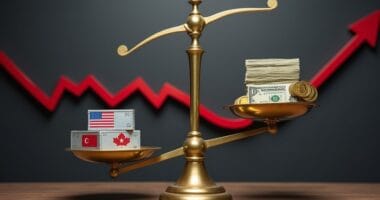While the White House touts $15.9 billion in tariff revenue, economists say the math doesn’t add up. The 10% blanket tariffs and targeted rates up to 145% on Chinese goods are fundamentally a hidden tax on American consumers. Market experts warn of an economic storm brewing, with rising prices and supply chain disruptions. The BOOM AMERICA initiative’s promises of prosperity clash harshly with financial realities. The full story reveals some uncomfortable truths.

Ambition met reality head-on as former President Trump’s sweeping “Liberation Day” tariffs delivered their first financial punch in April 2025. The numbers looked impressive at first glance – $15.9 billion in tariff revenue collected by April 24, dwarfing March’s total of $9.6 billion. Trump wasted no time taking to Truth Social, floating promises of eliminated taxes for Americans earning under $200,000.
But economists aren’t buying the rosy rhetoric. The blanket 10% tariff on all countries, coupled with targeted rates soaring as high as 145% for Chinese products, has experts warning of an incoming economic storm. Sure, the government’s coffers are filling up faster than a Mar-a-Lago swimming pool, but someone’s footing that bill – and it’s not foreign countries. The U.S. already maintains one of the lowest tariff rates globally at just 3.3% compared to its trading partners. Market liquidity has notably decreased as trading volumes shrink under the new tariff pressures.
The White House’s “BOOM AMERICA” initiative, declared under the International Emergency Economic Powers Act, has morphed into a complex web of rates and exceptions. Auto imports now face a 25% duty, while various industries negotiate special deals and exemptions. It’s about as straightforward as a presidential tweet at 3 AM. The initiative exempts several critical sectors, including steel and aluminum from reciprocal tariffs.
Meanwhile, Trump’s administration keeps modifying the rules faster than you can say “trade deficit.” The policy’s stated goals sound noble enough: restore manufacturing, protect American industry, and strengthen the defense-industrial base.
But economists point out that these tariffs are fundamentally a tax on American consumers, wrapped in red, white, and blue packaging. The reality is simple: when foreign goods cost more, Americans pay more. Period.
While the Treasury Department categorizes this windfall as “customs and excise taxes,” the money ultimately comes from U.S. consumers’ pockets. Those promised tax cuts? They’re about as solid as a chocolate teapot in July.
As the White House celebrates its revenue surge, economists warn of potential recession, supply chain disruptions, and rising living costs. Trump’s bold promises might sound good on social media, but the math tells a different story – one that doesn’t add up to American prosperity.





